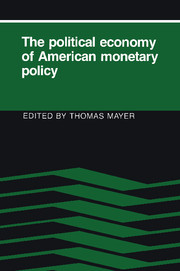Book contents
- Frontmatter
- Contents
- Preface
- List of contributors
- 1 Introduction
- 2 Studying the Fed: toward a broader public-choice perspective
- 3 The Federal Reserve reaction function: a specification search
- 4 Corporate profitability as a determinant of restrictive monetary policy: estimates for the postwar United States
- 5 Federal Reserve behavior since 1980: a financial-market perspective
- 6 The Federal Reserve and its institutional environment: a review
- 7 The political economy of monetary policy
- 8 Political monetary cycles
- 9 Congress and the Fed: why the dog does not bark in the night
- 10 The Federal Reserve as a political power
- 11 Monetary policy and political economy: the Federal Reserve and the Bank of Japan
- 12 A positive analysis of the policy-making process at the Federal Reserve
- 13 A theory of FOMC dissent voting with evidence from the time series
- 14 Explaining FOMC members' votes
- 15 Fed behavior and X-efficiency theory: toward a general framework
- 16 Minimizing regret: cognitive dissonance as an explanation of FOMC behavior
- 17 The discount window
- 18 Leaning against the wind: the behavior of the money stock in recession and recovery, 1953–8
- 19 Bureaucratic self-interest as an obstacle to monetary reform
- Index
8 - Political monetary cycles
Published online by Cambridge University Press: 06 July 2010
- Frontmatter
- Contents
- Preface
- List of contributors
- 1 Introduction
- 2 Studying the Fed: toward a broader public-choice perspective
- 3 The Federal Reserve reaction function: a specification search
- 4 Corporate profitability as a determinant of restrictive monetary policy: estimates for the postwar United States
- 5 Federal Reserve behavior since 1980: a financial-market perspective
- 6 The Federal Reserve and its institutional environment: a review
- 7 The political economy of monetary policy
- 8 Political monetary cycles
- 9 Congress and the Fed: why the dog does not bark in the night
- 10 The Federal Reserve as a political power
- 11 Monetary policy and political economy: the Federal Reserve and the Bank of Japan
- 12 A positive analysis of the policy-making process at the Federal Reserve
- 13 A theory of FOMC dissent voting with evidence from the time series
- 14 Explaining FOMC members' votes
- 15 Fed behavior and X-efficiency theory: toward a general framework
- 16 Minimizing regret: cognitive dissonance as an explanation of FOMC behavior
- 17 The discount window
- 18 Leaning against the wind: the behavior of the money stock in recession and recovery, 1953–8
- 19 Bureaucratic self-interest as an obstacle to monetary reform
- Index
Summary
There are rhythms in American political life. There is the regular fouryear electoral rhythm, as well as the more irregular rhythm of party alternation in control of the White House. It would be surprising if economic policy and outcomes did not resonate with these rhythms. Much empirical research has been done on this question. As is typical, there are contradictory findings, but it seems quite clear that economic policy and outcomes do vary with control of the White House, and it is likely that policy and outcomes vary with the electoral calendar. Are there similar rhythms in monetary policy? The answer is less clear. The Fed, after all, was set up to be insulated from these political rhythms. In this chapter I shall look at some arguments and some evidence for electoral or partisan rhythms in the making of monetary policy.
I take as uncontroversial that presidents wish to be reelected; if one is not eligible for reelection, one prefers that the White House remain with one's party. Presidents may have other goals, and they may even rank those other goals more highly, but no one achieves the presidency without some interest in being elected. It follows from this that presidents will prefer policies that will help them get reelected, at least insofar as those policies do not conflict with other goals. We need not view the president as being willing to do anything to get elected in order to believe that he evaluates policies at least partially in terms of their effects on the next election.
- Type
- Chapter
- Information
- The Political Economy of American Monetary Policy , pp. 113 - 128Publisher: Cambridge University PressPrint publication year: 1990
- 3
- Cited by



